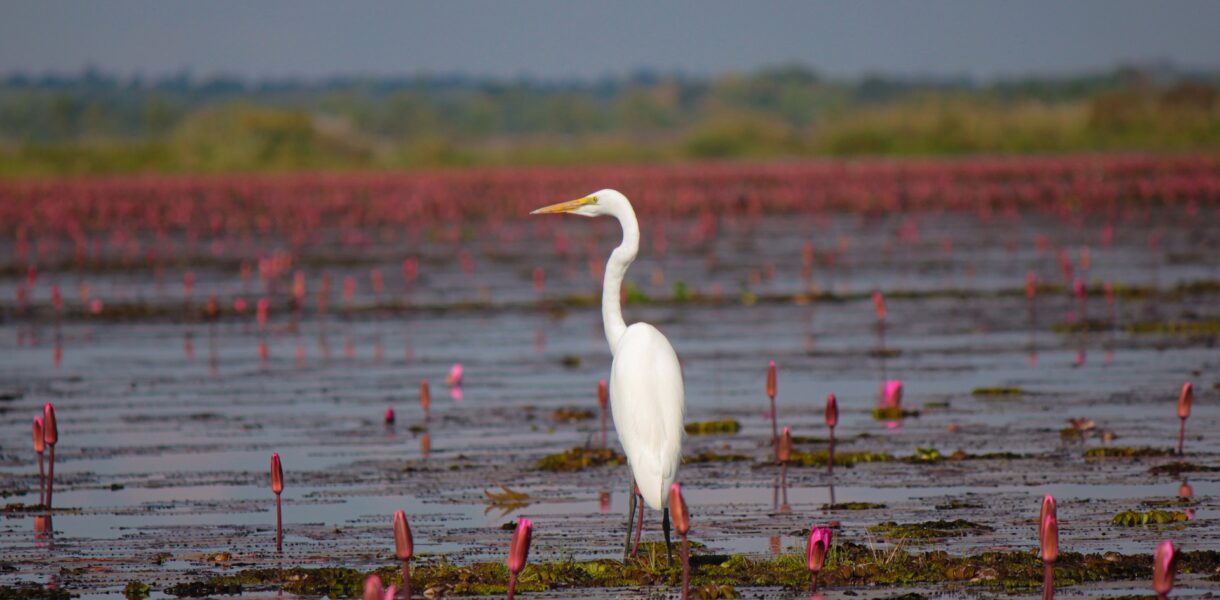
Introduction
Wetlands are a major part of the ecosystems of the world. Wetlands are those areas where water is the main factor in controlling the environment and the associated plant and animal life. They appear where the water table is at or near the surface of the land, or where the land is enfolded by water.[1]Wetlands vary widely due to the local and regional differences in the soils. They may vary based on climate, topography, water chemistry, hydrology, vegetation, and other elements including human disturbance.[2] The major threats to wetlands in India are pollution, invasion, Eutrophication, unlawful mining activities, unplanned tourism activities, and cultural misuse. According to the Clean Water Act, 1977[3]of the United States of America, wetlands mean those areas which are inundated or saturated by surface, open, or groundwater at a frequency and duration sufficient to support and that under normal circumstances do support, a familiarity of vegetation that are typically adapted for living in saturated conditions of the soil.[4]
Wetlands are known as a crucial source of storage of drinking water for the people. It plays a major role in providing farmers with a means of livelihood. Even though they are of great importance there is always a great danger to the ecosystem. Apart from natural causes such as calamities and climate change-induced effects, some threats such as soil-use change, encroachment, and contamination of the environment are also gradually blocking these wetland systems. In several Indian cities, urban flooding can be directly related to rampant development on reclaimed wetlands, flood plains, and lowlands of the cities. The protection of water comes under the state list, so, several states have proclamations and laws to preserve and protect their rivers, watersheds, and groundwater, but specific laws and rules on wetlands do not exist except for a few states. For example – The State of West Bengal had passed the East Kolkata Wetland (Conservation and Management) Act, 2006[5] to protect the East Kolkata Wetlands and it was being declared as a Ramsar site. Also, the state of Kerala enacted the Kerala Conservation of Paddy Land and Wetland Act, 2008[6] which forbids the reformation of paddy lands into construction sites. Even though these rules are in existence, there is poor implementation of rules that are destroying the wetlands. Wetlands are a major link between land and water. They add up to a major part of the earth’s biodiversity. Humans depend on the wetlands the most, as it provides sources of drinking water and food in the form of agricultural fields and fishing. It is very contradicting to hear that wetlands are a vital source of ecosystems for the humans but it is least protected by any legislation or the judiciary. In India, wetlands are reducing at a very fast rate especially in the urban sector due to encroachments and privatization of wetlands.
Research Questions
- Why is there a need for proper implementation of legislation for the protection of wetlands between the state and the central government?
- Due to the bad implementation of wetland rules, how are the wetlands being affected due to the encroachment of wetlands?
Theoretical Background
Public Trust doctrine is also a legal theory having importance on the principle of resources such as air, water, and forests. These resources have greater importance compared to people as a whole denying these resources to people as private ownership. Since the resources are given by nature, they must be made available to everyone without discriminating on their standard of living. The government is empowered by the doctrine to preserve the resources for collective interest and enjoyment of the public rather than providing only to private individuals as ownership or commercial developments. The Public Trust doctrine is given the status of Article 21 of the Constitution of India that is the ‘right to life and personal liberty. For a human’s right to life, the protection and preservation of resources become majorly important, without these human lives ceases to exist. Article 21, stating the right to life, has been extended to include the right to livelihood and the right to a healthy environment. The judiciary plays a major role in applying the doctrine of public trust to preserve and safeguard the public land and avoid it from being encroached. Due to the lack of proper legislation or rules on the protection of wetlands, the rate of encroachment of lands starts to increase in the urban cities. Climate change and environmental degradation have caused the wetlands to dry up and resulted in a shortage of water supply in the cities. So, the government has raised its position in protecting the wetlands through the public trust doctrine. Construction or demanding of individual ownership in public places cannot be issued by the judiciary due to the said doctrine.
The doctrine of Sustainable Development first came in the Declaration of Stockholm in 1972[7]. It has expressed that, ‘Man has the fundamental right to equality, freedom and adequate conditions of life, in an environment of a quality that permits a life of dignity and well-being and he bears a solemn responsibility to protect and improve the environment for present and future generation.’[8]The doctrine of sustainable development is further branched into; polluter pays principle and the precautionary principle.
- Polluter pays principle termed as a method concerned with repairing the damage caused. It initially focused on the international environmental law where the person causing the harm or damage, must pay the compensatory party. The party causing damage must also pay the restoring cost for environmental degradation. This is almost in line with absolute liability in India. The doctrine of an absolute liability says that if an individual is involved in a dangerous, unsafe, or hazardous activity or event and harm has been occurred to another person due to the accident carried out. The accident can be a dangerous or a hazardous one and the person who caused this act will carry absolute liability to compensate for the damages.
- The precautionary principle is the measures for the environment taken by the state government to prevent and target the causes of environmental degradation.[9] Also, where the threats are considered irreversible and serious, lack of whole technological certainty should not be used as a reason for postponing convenient measures to prevent environmental deterioration.[10]
Concerning the research paper, the right to environment is stated in Article 21 which also provides the right to life to human beings. Wetlands are a crucial source of drinking water for the cities. But they are more prone to encroachment or a site for easy disposal of waste by individuals and the commercial factories. To avoid the wetlands from getting polluted various doctrines are available which are used by the judiciary. The doctrine of sustainable development is known for providing an equal and quality livelihood for humans. When one individual causes harm to the environment such as polluting the wetlands, then they are violating the public’s right to consume natural drinkable water. The government has to take a stand in making clear-cut legislation for the wetlands as they are a major threat if they do not exist shortly.
Legislative Measures for the Protection of Wetlands
The government after the attainment of independence took care of protecting the water bodies such as lakes and wetlands. They made the doctrine of public trust mandatory by the judiciary to protect and preserve the wetlands. Therefore, there was a shift from privately occupying wetlands to the government protecting them. Article 48A12 of the Indian constitution states that “The State shall endeavor to protect and improve the environment and to safeguard the forests and wildlife of the country”. Article 51A read with its clause (e) of the Indian Constitution states that every citizen of India has a duty for protecting and improving the natural environment including lakes, forests, wildlife, and rivers, and to have compassion for living creatures. The legislature has given the provisions to protect the environment which includes wetlands, but there is no specific law that existed for the protection of wetlands. In India, the protection of wetlands is mainly managed by the Environment and Forest Ministry. The Wildlife Protection Act of 1972 played a vital role in India to create awareness of the importance of wetlands and to preserve them. Currently, the kinds of wetlands existing in India are the backwater, coastal wetlands, paddy fields, and reservoirs.[11]
The Central Government governs a few of the wetlands and the state government governs few wetlands coming under the region due to the mandate of Schedule VII of the Indian Constitution. The coastal wetlands and marine wetlands play a major role in protecting the coastline from storms, erosions, and climate regulation, but since each coastal wetland comes under different states, each state has its own rule in preserving it. Due to the lack of a centralized law, there is poor implementation and quick decision-making in the protection of wetlands. Another type of wetland, i.e., the highland wetlands are protected by the world heritage and is internationally protected due to their ecological significance, for example, the Himalayas and the Western Ghats in India. The wetlands had been coming under this category mostly lies in reserved forests and those are governed by major conventions and among one of them is the Ramsar Convention.[12]
The Accountability of Authorities for the Protection of Wetlands
The conservation of the national lake plan was implemented by the Environment and Forest Ministry which were primarily responsible for the protection of wetlands. Since the Central Government had powers for the functioning of water resources, agricultural land, and wetlands, few of the state bodies too, had powers to govern the wetlands. There was a lack of coordination and co-operation which led to the further exploitation of wetlands and their degradations. The Ministry of Fisheries had governed a few of the wetlands. The issue is very state-centric and the willingness to conserve the environment was at a very poor level. The major problem existing was the encroachment of wetlands by private investors who managed to declare the public site as private land. When the encroachment was rapidly grown in urban areas, the water level in cities started reducing. The central government incorporated the Wetlands (Conservation and Management) Rules, 2010.[13] The rules played an important role in the protection of wetlands in urban areas since it was a jurisdictional decision. Urban planning, parks, and land acquisition are environmentally sensitive since they can have a major impact on the protection of wetlands in urban areas. The rules provided a major criticism that they are situated in particular states must be governed only by them after the central government’s approval. Due to the lack of proper wetland database records, the protection of them was at risk again. Even with proper coordination and incorporating central legislation for all wetlands, still, the encroachment of wetlands is at grave misfortune.
Indian Judiciary on the Conservation of Wetlands
Under Indian Constitution, Article 48A allows for improvement and protection of the environment and for safeguarding the forest and wildlife, and Article 51A (g) provides to conserve and protect our natural resources, flora, and fauna. In the case of MC Mehta v. Kamal Nath,[14] the Apex Court cited the English and Roman common law principle of public trust doctrine. The Court said, ‘the public trust was more than an endorsement power and ability of the State to use public land for public purposes. It is an affirmation of the state’s responsibility to preserve the shared heritage of wetlands lakes, streams, marshlands, and tidelands of the people. The Court also ordered the motel to pay compensation for the restitution of the environment and ecology of the region utilizing costs.’[15]As mentioned about public trust doctrine in the theoretical background, it means the doctrine that enjoins upon the Government to safeguard the resources for the general public’s enjoyment rather than permitting them to be used for private property or commercial objectives.
In certain cases of Bombay Dyeing & Mfg. Co. Ltd. v. Bombay Environmental Action Group[16]and Vellore Citizens’ Welfare Forum v. Union of India[17]it was said that the two vital features of sustainable development are the precautionary principle and polluter pays principle. Due to that the interests of the people in the society and their right to life must be taken into account. Taking into account the above case, the Calcutta High court, in the East Kolkata Wetland Area, declared Ramsar Convention. site under the East Kolkata Wetlands (Conservation and Management) Act, 2006[18] permitted the construction of a water treatment facility cited in the case of People United for Better Living v. East Kolkata Wetlands Management Authority[19]. The court formed a monitoring committee and directed the building to be undertaken in the most environmentally sustainable way. This judgment can also be seen in lines of doctrine of public trust as it vouches for the welfare of the people. The construction of the water treatment plant is done by the government for the public good and not for an individual’s interest. The case directly involving wetlands is M. Indira v. State of Tamil Nadu,[20] in which the State of Tamil Nadu argued that originally 5000 hectares of wetland had been reduced to 500 hectares over a period and that it is the responsibility of the State to protect the wetland included in the National Wetland Conservation Programme by the Government of India. The court declared that the government can declare deforestation and environmental protection against any land under the Forest Act and must obey the order of the state government. Since the protection of water and wetlands came under the state list, unlike Calcutta and Kerala, the Tamil Nadu government did not have any special legislation about the protection of wetlands. Ultimately, the state found that due to the absence of specific laws to protect wetlands, the forest act was appropriate to invoke the protection of wetlands. This case concludes the argument that there must be central legislation on wetlands that the states need to follow, especially in the urban cities where water shortages are more likely to occur.
Legal Critical Analysis on the Conservation of Wetlands
India is part of the Ramsar Convention, but to stop the exploitation of the wetlands, it does not own strong national laws. Ramsar has declared 2400 wetlands as Ramsar Sites among which India has around 42 listed under it. Although the government has classified different water bodies such as lakes, ponds, marshes, mangroves, backwaters, and lagoons as wetlands, these wetlands over years are converted to real-estate investments or into a sewage and garbage dumping site. In India, the Ministry of Environment and Forests legalized a framework for the preservation and conservation of wetlands in 2010 under the umbrella legislation the Environment Protection Act, 1986. The framework has been named the Wetlands (Conservation and Management) Rules, 2010. The glitch here is that the wetlands rules of 2010 protect only the Ramsar sites which are listed and not the other wetlands such as paddy fields, mangroves, lagoons, and backwaters. The wetlands that have been excluded covers up half of the wetlands present in the country. The ministry has also excluded the coastal wetlands from the Wetlands Rules 2010 and it is said to come under the Coastal Regulation Zone, but the Coastal Regulation Zone completely denies this and fails to preserve the wetlands. The diminishing of wetlands is a major threat to the extinction of various plants and animals. The stormwater drains which are a major threat in the cities have been filled with sewage and garbage, allowing the rain and sewage water to flow on the roads. There has been a constant overlapping of legislation and a lack of strong legislation being present. The Wetlands Rules of 2010 also provide that, the wetlands must be free from conflict of interest. The Government and certain private agencies have encroached on the lake beds causing decreasing in the water body. The residents or the people living close to the lakes are always in conflict with the real-estate agencies as their right to using public property has been denied. The governments usually lease out the property, much of which would include the encroached lands. In case of any violation in this sector, the rules do not mention any punishments or remedies to the offense. Most of the wetlands in the urban and suburban regions are controlled by the municipalities and the village panchayats. Wetlands being a significant source of drinking water and irrigation for agricultural lands, the municipalities have great initiatives to protect and preserve them. But the private real-estate usually involves the government for development purposes and the wetlands eventually succumb. The wetlands are said to be inspected during the summer season when the water is relatively low or there is no water. In these times, the wetlands usually turn into dump lands and get filled with garbage, causing more depletion of wetlands. Looking at these entire loopholes, the government must pass an Act, the Wetlands Conservation Act in line with the Environment Protection Act, 1986. This would help in conserving and protecting the wetlands from being encroached and privatized. Severe punishments must be imposed on the illegal offenses created in harming the wetlands. Water scarcity being a major threat in the present world, conserving more wetlands would be the only solution in the years to come.
Conclusion
Looking at the various cases of encroachment throughout India, it can be concluded that due to the lack of specific laws or legislations encroachment of wetlands is increasing. The increase of encroachment in the urban sectors will in turn cause floods in the cities, denying people basic water, food, and amenities. Shortly wetlands will soon be less in numbers affecting a huge number of people. The wetlands are significant and need conservation for the survival of future generations. It is recognized socially and culturally which is of great importance to communities and the need for protection. The government must enforce proper rules and must present clear clarity. The wetlands can be conserved and protected when the government and the people come together to be out the views concerning it and bring out national legislation.
Photo Credits: Planet Outlook
About the Author
I am Ashwin Singh. I am pursuing BBA LLB from Symbiosis Law School, Pune. I am a fast learner and want to learn as much as I can during my law school period, through internships, online course, etc. I am a passionate second-year law student with a drive to observe, adapt, and apply knowledge to bring a positive change. While maintaining a great academic record during both my Senior Secondary Schooling as well as in Law School, I have been successful in manifesting opportunities to hone my skills in both legal research and academic writing. I hold a keen interest in Contract Law, Family Law, Environmental Law, and Constitutional Law. My hobbies include reading History, Mythology, Singing Sea Shanties, and Playing Video games.
References
-
Our Wetlands, Ramsar Norbal Wet Initiative, (June, 2005) https://www.norbalwet.org/our-wetlands/. ↑
-
What is a Wetland?, US Environmental Protection Agency, (June 12, 2018), https://www.epa.gov/. ↑
-
Clean Water Act, 33 U.S.C. §§ 1251-1387 (1977). ↑
-
U.S. Environmental Protection Agency, How Wetlands are defined and identifiedunder CWA Section 404,U.S. Environmental Protection Agency, (Sept. 26, 2016, 02:10 PM), https://www.epa.gov/cws-404/how-wetlands-aredefined-and-identified-under-cwa-Section-404. ↑
-
The East Kolkata Wetland (Conservation and Management) Act, 2006, No. 404-L, Acts of the West Bengal Legislature, 2006. ↑
-
The Kerala Conservation of Paddy Land and Wetland Act, 2008, No. 28, Acts of the Kerala Legislature, 2008 ↑
-
2398 (XXIII), U.N.G.A., UN Conference on the Human Environment Stockholm, June 5, 1972 ↑
-
Eloamaka Carol Okonkwo, Environmental Justice and Oil Pollution Laws: Comparing Enforcement in the United States And Nigeria, (Routledge Taylor & Francis Group, 2020). ↑
-
Harpreet Kaur,Precautionary Principle, Academike Lawoctopus (Feb. 04, 2015), http://www.lawctopus.com/academike/precautionary-principle/. ↑
-
Id. ↑
-
Gopal, B.& Sah, M.,Inventory and Classification of Wetlands in India,118 (½) Vegetation Springer JSTOR 39, 48 (1995). ↑
-
49/426, U.N.G.A.,Convention on Wetlands of International Importance Especially as Waterfowl Habitat, Ramsar, Feb. 2, 1971. ↑
-
Part II Section 3 sub-section (ii), The Wetlands (Conservation and Management) Rules, 2010, Ministry of Environment and Forests, 2010. ↑
-
M.C. Mehta v. Kamal Nath, (1997) 1 S.C.C. 388. ↑
-
Id. ↑
-
Bombay Dyeing & Mfg. Co. Ltd. v. Bombay Environmental Action Group& Ors, (2005) 5 S.C.C. 61. ↑
-
Vellore Citizens’ Welfare Forum v. Union of India, A.I.R. 1996 S.C. 2715. ↑
-
East Kolkata Wetlands (Conservation and Management) Act, 2006, No. 7, Acts of West Bengal Legislature, 2006 ↑
-
People United for Better Living in Calcutta v. East Kolkata Wetlands Management Authority, A.I.R.1993 Cal.215. ↑
-
M. Indira v. State of Tamil Nadu & Ors, (2012) 3 M.L.J. 646. ↑





This page really has all of the info I needed concerning this subject and didn’t know who to ask.
wonderful points altogether, you just gained a emblem
new reader. What would you recommend in regards to your post that you made some
days ago? Any certain?
I loved as much as you will receive carried out right here.
The sketch is attractive, your authored subject
matter stylish. nonetheless, you command get got an impatience over that you wish be delivering the following.
unwell unquestionably come more formerly again as
exactly the same nearly very often inside case you shield this hike.
Woah! I’m really digging the template/theme of this site.
It’s simple, yet effective. A lot of times it’s tough to get that “perfect balance” between superb
usability and visual appeal. I must say you’ve done a amazing job with
this. Additionally, the blog loads super fast for me on Firefox.
Superb Blog!
Wow that was unusual. I just wrote an really long comment but after I clicked submit my comment didn’t appear.
Grrrr… well I’m not writing all that over again.
Anyhow, just wanted to say excellent blog!
Have you ever considered about adding a little bit more than just your articles?
I mean, what you say is valuable and everything. But just imagine if you added some great visuals or videos to give your
posts more, “pop”! Your content is excellent but with images and video clips,
this site could definitely be one of the best in its niche.
Awesome blog!
Hello there! This article couldn’t be written much
better! Reading through this article reminds me of my previous roommate!
He constantly kept preaching about this. I am going to send this post to him.
Pretty sure he’ll have a good read. I appreciate you
for sharing!
These are actually great ideas in on the topic of blogging.
You have touched some nice points here. Any way keep up wrinting.
I do believe all of the concepts you have offered on your post.
They are really convincing and will certainly work.
Nonetheless, the posts are very quick for newbies. May just you please prolong them a little from subsequent time?
Thanks for the post.
Health to the hands of the person who made the application, it works smoothly ????